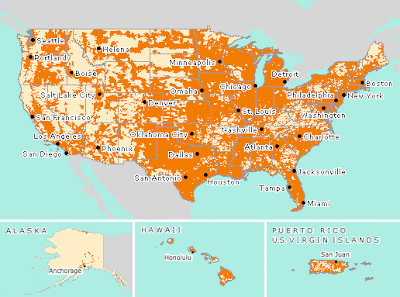Verizon has blitzed the TV and print media with their clever "There's a map for that" advertisements. Given the ease of manipulating this type of map, I'm surprised that this ad has gone virtually unchallenged so far. Does Verizon's map color in any area of reception regardless of how spotty? Are the map projections the same? Does the red vs blue scheme imply some kind of secret Republican bias on the part of Verizon?
I wasted way too much time on a somewhat extensive web search and found nothing out there that challenges this ad. Here is a screenshot from the ad.

Here's a look at AT&T's "coverage viewer" map - it tells a slightly different story.

Both carriers, Verizon and AT&T have interactive coverage maps. You can zoom down to street level to see your local coverage. However, if you live in any urbanized area you're likely to see nothing but a sea of color. Both of these pages have very similar disclaimers. Here's part of AT&T's.
"Map may include areas served by unaffiliated carriers, and may depict their licensed area rather than an approximation of their coverage. Actual coverage area may differ substantially from map graphics, and coverage may be affected by such things as terrain, weather, foliage, buildings and other construction, signal strength, customer equipment and other factors. AT&T does not guarantee coverage"
Sounds like lots of gray areas that can go either way depending on whose map you're making.
 The obvious lesson in all of this-don't believe everything you see in advertisements-or maps.
The obvious lesson in all of this-don't believe everything you see in advertisements-or maps.Or on this blog (See below)!!!!!
CORRECTION:
So, as anonymous commenter pointed out, the AT&T map I show above from their website is a "Voice & Data" map, not 3G. As are both of the coverage viewers that I linked to above. You can get a 3G map from AT&T but it's very tricky-if you really want it look for instructions in the comments. The map you will find is actually pretty similar to the map shown in the ad.
What's the difference? Is it just speed or are there things you can't do with "Voice & Data?" I don't know enough about this stuff to speculate.
So if I've unfairly portrayed Verizon as a bunch of liars, sorry about that. However, I am still very skeptical about their own coverage map and the entire premise of the ad. As the Verizon disclaimer says:
"This does not show exact coverage. Wireless service is subject to network and transmission limitations, particularly near boundaries and in remote areas"
If you want maps that are better than the blurry ones in the ads, see the Verizon 3G page.

3 comments:
The AT&T map you show is actually their entire network, rather than their 3G network. They actually don't even show a map of their 3G coverage, you have to click the link at the bottom of the page and look at it as text.
An easy example is that they have zero 3G coverage in Montana according to their "3G coverage list", while the map they show on their "network coverage" page shows lots of Montana spots.
Oh man! You got me on that one! I didn't realize I was looking at "Voice & Data" rather than 3G.
You can get map of their 3G coverage if you click the "in select areas" link, pick any city and zoom out to any level except nationwide. In defense of Verizon, AT&T's coverage map is pretty similar to the ad though there is a bit more of it in places. Still, I'm skeptical that Verizon's 3G works well in all of those red areas.
Verizon's network is all 3G. But it probably doesn't work well in all of those areas; as an iPhone user I can attest that ATT's 3G certainly doesn't work well in all of its 3G areas!
I think you just have to choose a carrier and hope for the best in your particular area. Living in a 3G area marked "best" coverage on ATT's map gives me one bar of signal and calls dropped about 25% of the time.
Post a Comment